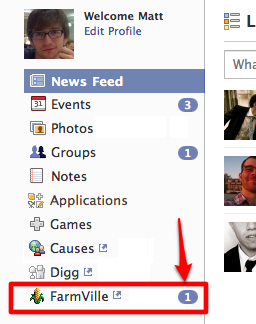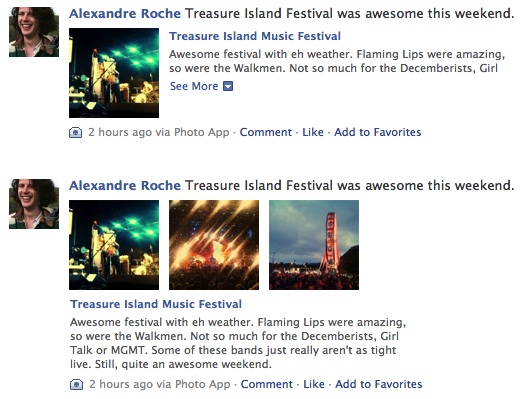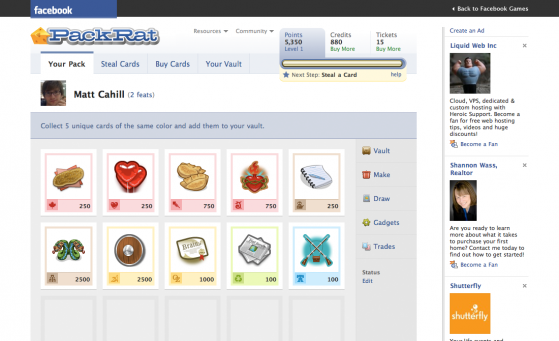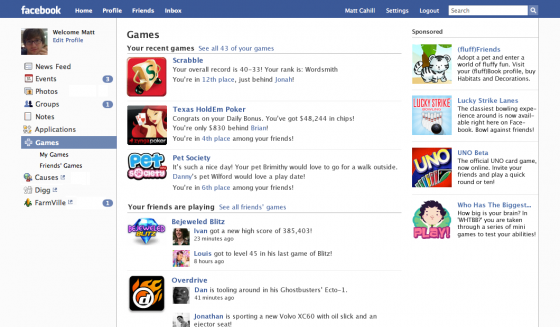Last night, during a webcast, Facebook announced some upcoming significant changes to the Facebook platform. Most are good, a few may be frustrating, but here they are. These changes will start to be rolled out in November & December and will continue into the first and second quarter of 2010.
If you develop Facebook applications, I strongly encourage you to check out their new Facebook Developer Roadmap, which breaks down upcoming changes in detail and let’s you know when to expect these changes to roll out.
I for one am thrilled to see Facebook finally trying to work with developers to give them a clear idea of what to expect and when. As someone who has spent the past two years writing Facebook applications and being frustrated by surprise platform changes, this is a giant step in the right direction from my point of view. Previously, it was not uncommon to get only a day or two’s notice – or no notice at all – regarding critical application functionality. If you’re the developer for one application, that’s inconvenient and annoying at best, if you’re obligated to maintain a dozen or so applications it can be utterly traumatizing.
From the look of things, Facebook is trying to streamline the way applications communicate with users, and is adding some features specifically designed to improve the flow of turn-based gaming and make it easier for users to find games amid the sea of applications in the app directory.
Overall, these changes bring new features to the application developer’s toolbelt, but changes to the newsfeed and Stream API also mean that several of the ways you were previously able to send messages to a user’s newsfeed/stream (the one you just updated in April to comply with their last round of newsfeed changes) will no longer be supported.
To put a finer point on it, if you don’t feel like extending your current applications to take advantage of the new features, you will still need to update them to get them to function as they currently do. If you do not update your application to use the Stream API, your application will NO LONGER send any messages to your users’ stream. More on this down below.
So here’s a quick run-down of what to expect in the next few months – I’m covering the issues that will affect current applications first, and then we’ll get into the good stuff that talks about new features and functionality, so you know what you have to update to keep your existing functionality before worrying about extending it.
Big changes to the Stream, old API not supported, templates disappear, new format
As I mentioned above, if you don’t care enough (or your clients are not paying you enough) to update your current applications with the new functionality these updates bring, you’re still going to have to spend some time in the code just to get them not to break.
As of December 20, 2009, when Facebook.showFeedDialog and feed templates are discontinued, if your application hasn’t been updated to use Stream.publish, Facebook.streamPublish, or FB.Connect.streamPublish, your application will no longer be able to send newsfeed messages.
These Stream API functions will be the only way to send messages to users’ streams and they are available right now, so I encourage you to start making the switch now so you have plenty of time to test and troubleshoot any issues that come up.
But wait – there’s more!
Stream stories will be rendered slightly differently, with only one image and few lines of text. Only the first image and first few lines of text will be rendered by default. A user can choose to expose the rest of the images and text by clicking a “See More” link.
Only one action link will be rendered, and it must be 25 characters long or less. “Formatting”-style characters (like “|”, “[“, “]”, and others) will not be rendered.
Key Policy Change: In order to encourage intentional behavior, you will no longer be able to automatically pop up a Feed form for a user unless that user has explicitly indicated that he or she wishes to share this information. According to Facebook, “a user should never be surprised by a Feed form”. You can continue to render Feed forms through FB.Connect.streamPublish and Facebook.streamPublish.
In the Stream Roadmap page, they outline when it is appropriate to open a feed form:
- When the user has clicked a button that says “Share this”.
- When a user has indicated via your user interface that they want to share. For example, if a user wrote a review within your application, and they checked a box that said “Share with friends” next to your “Publish this review” button. If you pre-checked a “Share with friends” box and they unchecked it, a Feed form should not pop up.
Perhaps more importantly, they also outline when you should NOT prompt the user with a feed form (and therefore NOT allow your user to post the action to their stream):
- When a user takes an action that is a normal part of using your application, for example, achieving a new high score.
- When you present a user with a result or new information, for example, completing a quiz.
These last two will directly impact how a LOT of Facebook apps and games currently function. While it will no doubt have an adverse impact on monthly active users for the applications that currently trigger stream entries on these actions, it is most likely a response of Facebook users complaining about the tremendous influx of stupid quizzes that have been flooding their newsfeeds for the past several months.
Hopefully, the other changes detailed below will offset the impact of apps not appearing in the stream as often and will more than compensate for any loss in virality.
Check out the Stream Roadmap page on the Facebook Developers site for full details.
No more Profile boxes or Boxes tab
That’s right. Poof. Going forward (in the short term) application tabs will be the only way applications can integrate into Profiles. We will be removing profile boxes, application info sections, and the Boxes tab. Facebook says they are exploring additional ways to enable developers to integrate into Profiles.
Please note that it does NOT appear that Facebook will be moving application content currently in Profile boxes or the Boxes tab into Profile tabs for you. From the Profile Roadmap page on the Facebook Developer’s Wiki:
Where will users’ profile boxes go?
Profile boxes will not exist in the near future. Application tabs will be the only way developers can integrate into the profile. If integrations on the profile are an important part of your application, we encourage you to focus development and transition to application tabs.
(Timing: Late 2009/Early 2010)
So it looks like if you don’t make this change to your application yourself and you rely on Profile boxes or Boxes tab boxes for your application to work, your app will effectively just disappear from user profiles when this change goes live.
Application tabs will shrink from 760 pixels wide (today) to 510 pixels 520 pixels wide to accommodate a slightly revised design. Boxes, info sections, and the Boxes tab will be removed in the near future. This kind of sucks, in my opinion, but I assume they’re doing it to accommodate a new design with either larger ads or some sort of right-rail navigation. Still, that’s a 250 240 pixel loss of real estate. Bummer.
Update as of Dec 15, 2009: According to a recently updated roadmap page, they will be shrinking the tabs down to 520 instead of 510. This, along with other profile changes, is set to roll out early 2010 by their last estimate.
Slight Application Canvas page layout change. In order to make it clearer to users when they are using an application created by a third party developer, Facebook is going to slightly modify how the top-navigation is rendered on canvas pages:
Looks like they’re still tinkering with ideas on the new layout of Application Canvas pages, but overall this shouldn’t impact most applications too much. They encourage developers to periodically check the Canvas Roadmap page for updated designs.
Now then – we’ve covered all of the stuff that impacts your current applications as they are now. Let’s look ahead to some of the great new functionality ahead.
Developers will be able to ask users to share their primary email addresses. This is a big deal because it was previously verboten to collect a user’s email address without specifically asking them to type it into a form and submit it. (Timing: Nov 2009)
New Application Counter (woot!)
 The application counter is one of my favorite improvements laid out in this roadmap and is just one of many steps Facebook is taking to position itself as a gaming platform.
The application counter is one of my favorite improvements laid out in this roadmap and is just one of many steps Facebook is taking to position itself as a gaming platform.
You will have the opportunity to increment your count to indicate to a user that they should take an action in your application, for example, take their turn in a game, or see a comment from another user on content they created within that application.
The count can be incremented by your application, and when a user clicks through to the application, the count will be reset to zero.
As we continue to see an influx applications leveraging Facebook as a platform for RPG and turn-based gaming, it seems Facebook is getting behind the idea and beginning to provide specific features to encourage growth in this area. (Timing: November/December 2009)
Games/Applications Dashboards
In fact, apps that are games will be separated by category from apps that are… well, applications. Plus, users have access to two different Dashboards, one for Games and one for Applications.
The Games dashboard will have a number of features that encourage users to find games their friends and playing, and to stay active in games they’ve started, including:
Recent games: Facebook will prominently display games that a user has recently played, showing the application icon and application name. Clicking on a game will take the user to the game’s canvas page.
Game News: There will be a text field next to each game on the dashboard where developers can set Game News. This area is free form and targetable by user, e.g. “You are ranked 17th among your friends. Austin’s score is the next highest at 28,400. Can you beat him?” or, “Your pumpkins are wilting – water them soon!”
Your friends are playing: Facebook will display some of the games that your friends are playing along with information about relevant activities in the game.
According to Facebook, an app cannot appear in both the Games directory and the Applications directory, and they’ll be reviewing Games listed in the Games directory to make sure they belong there.
All non-game applications will have similar functionality (your recent applications, application news messages, and applications your friends are using) in the Application Dashboard.
Application Notifications
Facebook is removing application-to-user notifications and user-to-user notifications. Instead, they encourage you to use other channels to communicate directly with your users, and to enable them to communicate with each other about your application.
Communication between you and your users:
They encourage you to use Email (once the user has opted to share their email address with you) for things like product announcements, newsletters, or billing and transactional communication.
If you want to notify users about an action they should take with your application (like taking their turn in a game), incrementing the Application Counter will be a good way to notify them.
The application news in the Application Dashboard will be a great way to share a brief message with a user while they’re exploring the Dashboards. You’ll be able to target these on a per-user basis.
Communication between your users and their friends:
The stream is the most powerful way to enable users to share their experiences with all of their friends.
The new Share flow will give your users the ability to send messages directly to their friends’ Inboxes, with attachments predetermined by you. This will be the best way to encourage one-to-one and one-to-few messages between users, and is intended to replace requests.
Users will still be able to invite their friends to check out your application.
The estimated timing on this is approximately 30 days after you are able to start requesting a user’s email address. (Latest estimate: November/December 2009)
Open Graph API: Incredible potential, or not at all?
The info on Facebook’s Developer page for this is a little vague at best. They state:
The Open Graph API will allow any page on the Web to have all the features of a Facebook Page. Once implemented, developers can include a number of Facebook Widgets, like the Fan Box, or leverage any API, which enable the transformation of any Web page so it functions similar to a Facebook Page.
For example, AwesomeTees might decide that strategically they would like to locate their brand identity at www.awesometees.com. AwesomeTees will install the Fan Box widget, which will allow any Facebook user to “Become a Fan” of AwesomeTees, thereby establishing an official connection to AwesomeTees. The user will then have AwesomeTees listed in their list of connections on their profile as Pages are represented today.
This isn’t that different than how it currently works, so that’s not really news. What is interesting is this one line n their description, further down:
Additionally, any content that AwesomeTees publishes on AwesomeTees.com will show up in the stream on Facebook like it normally would.
Wait, say what? It sounds like they’re saying that news updates that would normally appear on a website, and would have to be manually cross-posted to a brand’s Facebook fan page will somehow automagically appear. I would have to assume they will require some sort of XML or JSON standardized format that website news announcements will have to be published in, but there’s little detail out on this just yet. This feature is a ways off though, with initial versions not expected until the second quarter of 2010.
And finally – Verification goes away as a brand, becomes universal for all apps
According to the Principles, Policies and Verification roadmap, Facebook is doing away with paid Verification and is extending it out to all applications.
On December 1st, 2009 we’ll retire the Verification brand, as we scale what was a voluntary program into a universal requirement. There is no longer a submission process or fee, and there won’t be distribution boosts as the product will move towards more intentional user sharing. Starting today, we will suspend the processing of Verification submissions. All apps must meet Verification Checklist expectations and will be subject to review at any time.
So this means while you no longer have to shell out big bucks for your app to be verified, it also means that Facebook will probably be more aggressive about making sure all developer applications do meet their verification criteria, and will yank your app with ir without notice if it feels like your app isn’t up to snuff.
Full Timeline
To give you a little more perspective, here is the timeline of the upcoming Platform changes, based on Facebook’s Developer Roadmap and originally compiled by InsideFacebook.Com:
Late October 2009
- Simplified policies posted, verification program ended, and “extending verification standards to all applications”
- Platform Live Status tool launching, which will show “updates on platform stability and load”
November 2009
- New email permission API (developers can ask users to share their email address)
- Access point to invites will be moved “to either a filter in Inbox or surfaced in the Application and Games Dashboards”
- User-to-user Inbox APIs will be launched
- Stream story formatting changes (1 image shown by default, few lines of text, 1 action link)
- New “add bookmark” button
November/December 2009
- Notifications API (both app-to-user and user-to-user) will be removed (note: Facebook says this will happen “30 days after email permission is available”)
- Feed forms cannot be popped open without “explicit user intent” (note: this is a new Facebook policy)
- Application bookmarks moving from the bottom menu bar to the left side of the home page
- Counter API launching (counts can appear on home page application bookmarks)
- Applications and Games dashboards launching
- New application branding on canvas pages launching
December 2009
- All stream publishing APIs beside Stream.publish, Facebook.streamPublish, and FB.Connect.streamPublish will no longer be supported (December 20)
- Revamped developer site launching
Late 2009 / Early 2010
- Requests API will be removed (note: Facebook says this will happen “30 days after launching new Inbox sharing”
- Profile boxes will be removed (application tabs will be the only way to integrate into the profile page at that point)
- Improved analytics and APIs launching
Early 2010
- Open Graph API launching
Conclusion
So it feels like Facebook might finally, really be getting their shit together. This is arguably one of the biggest rounds of changes to the platform that we’ve seen in quite some time, and for the first time, they’re actually giving developers a head’s up and being very transparent about timing and impact.
All in all, the vast majority of these changes are great news for application developers. We’re getting tons of new features, new integration points and opportunities for viral engagement. The trade-off in what we’re losing seems to be well worth it, if all of these improvements come to fruition.


